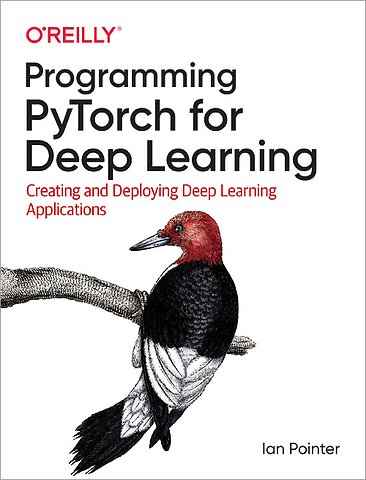

Currently Ian is the Director of Partner Engineering at a company called Kogentix that specializes in Machine Learning solutions (including Deep Learning techniques), with multiple Fortune 100 clients.
Meer over Ian PointerProgramming PyTorch for Deep Learning
Creating and Deploying Deep Learning Applications
Paperback Engels 2019 1e druk 9781492045359Samenvatting
Deep learning is changing everything. This machine learning method has already surpassed traditional computer vision techniques, and the same is happening with NLP. If you're looking to bring deep learning into your domain, this practical book will bring you up to speed on key concepts using Facebook's PyTorch framework.
Once author Ian Pointer helps you set up PyTorch on a cloud-based environment, you'll learn how use the framework to create neural architectures for performing operations on images, sound, text, and other types of data. By the end of the book, you'll be able to create neural networks and train them on multiple types of data.
- Learn how to deploy deep learning models to production
- Explore PyTorch use cases in companies other than Facebook
- Learn how to apply transfer learning to images
- Apply cutting-edge NLP techniques using a model trained on Wikipedia
Specificaties
Lezersrecensies
Inhoudsopgave
Deep Learning in the World Today
But What Is Deep Learning Exactly, and Do I Need a PhD to Understand It?
PyTorch
What About TensorFlow?
Conventions Used in This Book
Using Code Examples
O’Reilly Online Learning
How to Contact Us
Acknowledgments
1. Getting Started with PyTorch
Building a Custom Deep Learning Machine
GPU
CPU/Motherboard
RAM
Storage
Deep Learning in the Cloud
Google Colaboratory
Cloud Providers
Which Cloud Provider Should I Use?
Using Jupyter Notebook
Installing PyTorch from Scratch
Download CUDA
Anaconda
Finally, PyTorch! (and Jupyter Notebook)
Tensors
Tensor Operations
Tensor Broadcasting
Conclusion
Further Reading
2. Image Classification with PyTorch
Our Classification Problem
Traditional Challenges
But First, Data
PyTorch and Data Loaders
Building a Training Dataset
Building Validation and Test Datasets
Finally, a Neural Network!
Activation Functions
Creating a Network
Loss Functions
Optimizing
Training
Making It Work on the GPU
Putting It All Together
Making Predictions
Model Saving
Conclusion
Further Reading
3. Convolutional Neural Networks
Our First Convolutional Model
Convolutions
Pooling
Dropout
History of CNN Architectures
AlexNet
Inception/GoogLeNet
VGG
ResNet
Other Architectures Are Available!
Using Pretrained Models in PyTorch
Examining a Model’s Structure
BatchNorm
Which Model Should You Use?
One-Stop Shopping for Models: PyTorch Hub
Conclusion
Further Reading
4. Transfer Learning and Other Tricks
Transfer Learning with ResNet
Finding That Learning Rate
Differential Learning Rates
Data Augmentation
Torchvision Transforms
Color Spaces and Lambda Transforms
Custom Transform Classes
Start Small and Get Bigger!
Ensembles
Conclusion
Further Reading
5. Text Classification
Recurrent Neural Networks
Long Short-Term Memory Networks
Gated Recurrent Units
biLSTM
Embeddings
torchtext
Getting Our Data: Tweets!
Defining Fields
Building a Vocabulary
Creating Our Model
Updating the Training Loop
Classifying Tweets
Data Augmentation
Random Insertion
Random Deletion
Random Swap
Back Translation
Augmentation and torchtext
Transfer Learning?
Conclusion
Further Reading
6. A Journey into Sound
Sound
The ESC-50 Dataset
Obtaining the Dataset
Playing Audio in Jupyter
Exploring ESC-50
SoX and LibROSA
torchaudio
Building an ESC-50 Dataset
A CNN Model for ESC-50
This Frequency Is My Universe
Mel Spectrograms
A New Dataset
A Wild ResNet Appears
Finding a Learning Rate
Audio Data Augmentation
torchaudio Transforms
SoX Effect Chains
SpecAugment
Further Experiments
Conclusion
Further Reading
7. Debugging PyTorch Models
It’s 3 a.m. What Is Your Data Doing?
TensorBoard
Installing TensorBoard
Sending Data to TensorBoard
PyTorch Hooks
Plotting Mean and Standard Deviation
Class Activation Mapping
Flame Graphs
Installing py-spy
Reading Flame Graphs
Fixing a Slow Transformation
Debugging GPU Issues
Checking Your GPU
Gradient Checkpointing
Conclusion
Further Reading
8. PyTorch in Production
Model Serving
Building a Flask Service
Setting Up the Model Parameters
Building the Docker Container
Local Versus Cloud Storage
Logging and Telemetry
Deploying on Kubernetes
Setting Up on Google Kubernetes Engine
Creating a k8s Cluster
Scaling Services
Updates and Cleaning Up
TorchScript
Tracing
Scripting
TorchScript Limitations
Working with libTorch
Obtaining libTorch and Hello World
Importing a TorchScript Model
Conclusion
Further Reading
9. PyTorch in the Wild
Data Augmentation: Mixed and Smoothed
mixup
Label Smoothing
Computer, Enhance!
Introduction to Super-Resolution
An Introduction to GANs
The Forger and the Critic
Training a GAN
The Dangers of Mode Collapse
ESRGAN
Further Adventures in Image Detection
Object Detection
Faster R-CNN and Mask R-CNN
Adversarial Samples
Black-Box Attacks
Defending Against Adversarial Attacks
More Than Meets the Eye: The Transformer Architecture
Paying Attention
Attention Is All You Need
BERT
FastBERT
GPT-2
Generating Text with GPT-2
ULMFiT
What to Use?
Conclusion
Further Reading
Index
Anderen die dit boek kochten, kochten ook
Rubrieken
- advisering
- algemeen management
- coaching en trainen
- communicatie en media
- economie
- financieel management
- inkoop en logistiek
- internet en social media
- it-management / ict
- juridisch
- leiderschap
- marketing
- mens en maatschappij
- non-profit
- ondernemen
- organisatiekunde
- personal finance
- personeelsmanagement
- persoonlijke effectiviteit
- projectmanagement
- psychologie
- reclame en verkoop
- strategisch management
- verandermanagement
- werk en loopbaan





